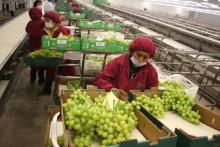Since taking office in December, Milei has drastically devalued the official currency, the peso, and ushered in austerity. The Argentinean peso has depreciated by around 2% a month through a controlled "rolling variation." Monthly inflation - although slowing down - has been around 10%-20% each month. All factors combined, prices have skyrocketed in US dollar terms.
Paraguayan shoppers used to flock to the border town of Nanawa to buy cheap imports from Argentina, where for years the weak peso kept low the relative prices of fuel, medicine and groceries smuggled across the border
Now Nanawa is a ghost town, with contraband prices soaring due to the rare combination of inflation close to 300% and a bolstered peso that has even recovered against the dollar in widely used parallel markets under libertarian President Javier Milei.
"Before, everything worked very well; we sold everything," says Marta, 57, a pharmacy employee in Nanawa, who only wanted to speak by her first name. "Now there's nothing left. We've been like this for two months, the town is dead."
Merchants in Nanawa, 30 kilometers from the capital, Asunción, estimated that sales had plummeted between 60% and 80% since Milei took office in December, when he drastically devalued the official currency, the peso, and marked the beginning of austerity.
Since then, the peso has been allowed to depreciate only 2% per month with a controlled "moving variation." Meanwhile, monthly inflation - although slowing - has been between 10% and 20% each month. That means prices in dollar terms have skyrocketed.
Something that cost 1,000 pesos on January 1 would have been worth $1.24 at the official exchange rate that day. With accumulated inflation of 65% until April, that same product would have cost 1,650 pesos, equivalent to 1.88 dollars, on April 30, an increase of more than 50%.
That has made Argentina much more expensive in relative terms, fueling analysts' claims that the peso is overvalued and, thus, requires another devaluation. Meanwhile, tourists and exporters have felt the impact of less competitive local prices.
"For Argentina, this process is painful," said economist Gimena Abreu, who analyzes relative prices on the border between Uruguay and Argentina at the Catholic University of Uruguay, adding that in the short term exports and tourism would be affected.
His team's data shows that the price gap between Uruguay and Argentina fell from 180% in September, before Milei took office, to 50% in March, when Argentine relative prices soared.
"In the short term, Argentine exports will become less competitive," Abreu said. Argentina's main exports include soy products, corn, wheat, beef, energy products and automobiles.
INCREASED PRICES
Raising costs for ordinary Argentinesnaffect consumption. Last September, a kilo of beef cost an average of 2,846 pesos (about $3.70 at the freely accessible parallel exchange rate), according to official data, much cheaper than a minimum of $7 in regional capitals such as Montevideo and Santiago de Chile.
The latest data shows that in April the price of Argentine beef went to 6,505 pesos, almost $7, largely erasing the cost advantage.
"My relatively comfortable lifestyle with dollar income has gone to the other extreme," said Buenos Aires resident Paige Nichols, 37, who moved to Argentina from the United States 17 years ago. "Now I need to be very conscious of what I spend."
Nichols said his monthly household spending had jumped about 150% since the December devaluation, driven primarily by health insurance, utilities and food.
Products like olive oil and toothpaste are becoming little luxuries. Reuters found that, on average, a half-liter bottle of olive oil costs $15 in Buenos Aires, with some brands reaching prices as high as $26. Colgate toothpaste cost 4,976 pesos or $5 for a single 90g tube, double what retailers in Paraguay and Uruguay charge.
Nichols, who works in the travel industry, said once-cheap prices for tourists were aligning with those of regional neighbors and even the United States. He said that dining out in Buenos Aires was almost double what it was a year ago.
'LESS PEOPLE CROSSING'
The above said, government data shows the number of incoming tourists rose in the first two months of the year, although there are signs of strain as prices rise --a potential risk to the $3.2 billion travelers brought in. to the economy last year.
Between January and March 2024, arrivals from neighboring Uruguay - which spent $1.3 billion in Argentina last year - fell 25% compared to the previous year, Uruguayan outbound tourism figures show.
Border towns in Paraguay, Chile and elsewhere have seen lower local demand for Argentine imports, but others have applauded the change in trend, which has also meant fewer locals taking day trips to Argentina in search of bargains.
"What I will say is that I have heard of fewer people crossing the bridge into Argentina to shop," said Lilian, a Uruguayan coffee shop owner who runs Helianthus Bistro in the border town of Fray Bentos, just across the Uruguay River from Argentina.
"Things are getting more expensive there, so there are no longer queues of cars crossing the bridge against each other."
Back in Nanawa, Raquel Alvarenga, a 36-year-old supermarket employee, said previous booming demand for cheaper Argentine imports meant the store had to expand outside its doors to handle the number of customers. Now, that is over.
"It has been quite damaging. Sales have dropped by 50% and it is hitting commerce... Argentine companies constantly raise their prices through the roof. They change every day," she said.
"Before, we had to serve people outside because we couldn't accommodate everyone in the store. Now we have time to drink terere (local tea)."










